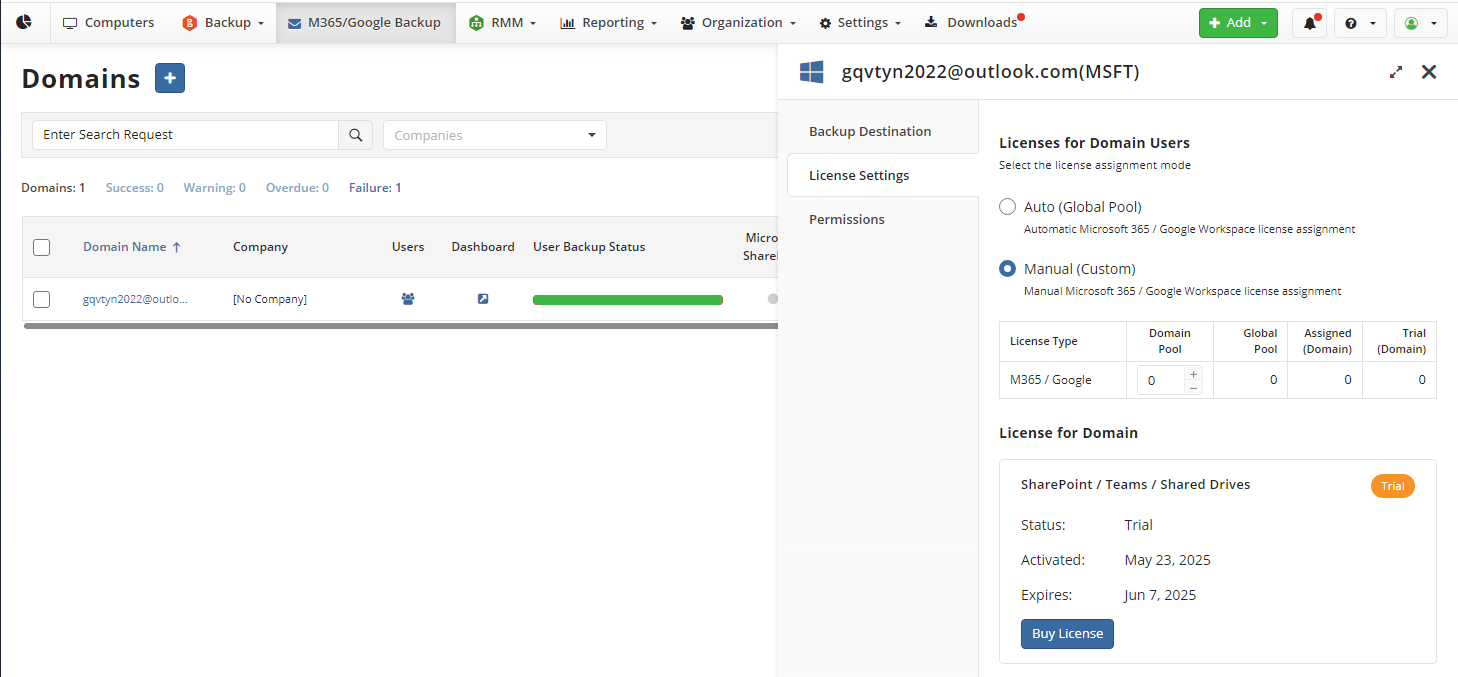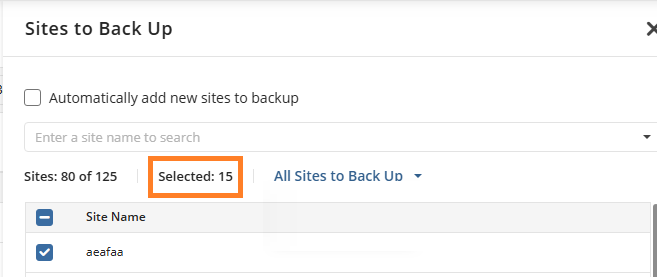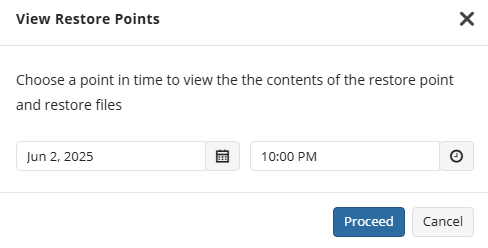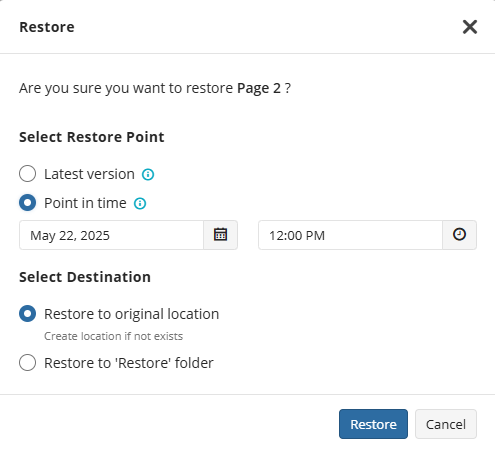SharePoint Backup
This chapter covers the following topics:
- Prerequisites
- Getting Started with SharePoint Backup
- Manage SharePoint Backup
- Browse Backup Content
- Add New Sites to Backup Automatically
- Restore SharePoint Sites
- Restore SharePoint and Teams Files
- Restore OneNote
- Delete SharePoint Backup Content
Prerequisites
To back up SharePoint sites, site pages, site assets, document libraries, as well as Teams files stored in SharePoint, make sure you have a valid SharePoint/Teams/Shared Drives license. A SharePoint/Teams/Shared Drives license covers all SharePoint sites, including Microsoft Teams files for a tenant.
To learn more about licensing, refer to the Licensing
Getting Started with SharePoint Backup
By default, SharePoint backup service is turned off for the added domain. To turn on the SharePoint backup service for the domain and assign a trial or commercial SharePoint/Teams/Shared Drives license, on M365/Google > Domains select the domain to edit the domain properties. In the Edit Domain dialog click Assign on SharePoint/Teams/Shared Drives license. Trial SharePoint/Teams/Shared Drives license will be assigned to this domain.
Now you can enable SharePoint backup.

To enable SharePoint backup, click Configure Backup on the dashboard, then turn on SharePoint backup service. To create the initial backup, click Save.
The initial backup task is created and will be scheduled automatically. You can monitor the backup task processing using the Task Manager.
Once the initial backup is completed, you can manage SharePoint backup. Consider that the storage limit for trial SharePoint/Teams/SharedDrives license is limited by 100 GB. You should purchase a commercial license to use more storage space.
Manage SharePoint Backup
To view SharePoint sites, libraries and Teams files stored in SharePoint, or to manage backup, select SharePoint in the horizontal menu bar. By default, SharePoint backups run automatically up to two times per day.

Click the Sites to Back Up button to select what sites will be backed up. Save your selection.

Add New Sites to Backup Automatically
You can add all new sites to backup automatically. To enable this feature turn on the Automatically add new sites to backup slider.

The number of sites added to backup can be viewed in the Selected counter.

You can add all sites to backup by selecting Enable or disable them.

Browse Backup Content
Administrators with Global Admin Access enabled can browse backup content to restore required content items for all domain users with enabled backup. Users if enabled can browse their own backups.

Select Restore Point
By default, the latest backup for the current date is shown. Starting with version 4.7, you can browse earlier restore points.

To view backups from another date:
- Click View Restore points on the horizontal menu.
- Select a date to switch to that restore point.

- You will be switched to the selected restore point. You’ll now see folders and documents (including earlier revisions) as they existed at the selected time and can perform restore operations for them.

Deletion is not supported in restore point view. To delete data, return to the current date
- To return to the latest backup, click Return to current date in the restore point banner.

Use Search
To find a file or folder, enter the full or partial filename and click the search icon. If a file was renamed, only the name relevant to the selected restore point will be searchable. Older names may still appear in file revisions, but can’t be searched directly. Type search expression and click the search icon to proceed. The search result appears in the right panel.

View Site Content
You can expand sites to see site content.

Use search to quickly find required sites or team files to backup. Type search expression and click the search icon to proceed. The search result appears in the right panel.
Restore SharePoint Sites
To restore a SharePoint site, select SharePoint in the horizontal menu bar. You can restore only one site at once.
- Click the root site in the navigation tree. Site list appears in the middle pane.

- Click the required site in the middle pane and select restore action above the grid. The following options are available:
- If you want the selected site to be restored as a new site, select Restore As New Site, enter a name for the new site and select a restore option for the site.

The following options are available: Latest version if you want to restore the latest version of your SharePoint or Teams files or Point in time. Select this option to specify date and time for the object version to be restored.
- If you want SharePoint and Team Files to be restored to Restore folder of the existing site, select Restore to 'Restore' Folder. Select an existing site and a restore option for the document library.

The following options are available: Latest version if you want to restore the latest version of your SharePoint or Teams files or Point in time. Select this option to specify date and time for the object version to be restored.
The restored objects become available in the Restore folder in the Documents folder of selected site.

You can monitor the restore task processing using the Task Manager.
Restore Deleted Sites
You can use the Restore As New Site option to restore a deleted site which is still in the backup. You can select the original site name for restore.

Restore SharePoint and Teams Files
To restore a single item from SharePoint Document Library or Teams files located in Teams' documents, select SharePoint in the horizontal menu bar. Refer to the Prerequisites for Restore Operations chapter to avoid any issues.
- Browse the content to select a file or folder to restore. You can find a necessary object by name or part of the name. Type the search expression and click the search icon.
- Click the item and select restore action above the grid. The following restore locations are available:
- If you want selected objects to be restored to the original location, select Restore
- If you want selected objects to be restored to the Restore folder, select Restore to 'Restore' Folder. This restores SharePoint data back to SharePoint to the same SharePoint site and library to the Restore folder.
- Select a Restore Option. Choose one of the following options to proceed with restoring your SharePoint and Teams files:
- Latest version. Restore the most recent version of your files and folders.
- Point in Time. Restore files and folders to their exact state as of a specific date and time.

- If any items were renamed, they will be restored using the names that were actual at the selected point in time.
- Consider, if any of the selected objects has no revisions after this point of time (was changed before this point of time), this object will not be restored.
Restore File Revisions
Also you can download selected file revision to your Downloads folder. To download the required item, browse the backup content, then click the particular item to view its revision list. Revisions appear to the right. Click the required item revision to download it to the Downloads folder.

After the download is complete, the item appears in your Downloads folder.
You can monitor the restore task processing using the Task Manager.
Also you can download selected file revision to your Downloads folder. To download the required item, browse the backup content, then click the particular item to view its revision list. Revisions appear to the right. Click the required item revision to download it to the Downloads folder.
- After the download is complete, the item appears in your Downloads folder
Restore OneNote
To restore a full OneNote notebook from SharePoint assets, select SharePoint in the horizontal menu bar.
- Expand the root folder, find the site containing the OneNote notebook, and then expand the site Assets.
- In the middle panel, browse the content to select an OneNote notebook to restore.

You can find a necessary object by name or part of the name. Type the search expression and click the search icon.
- Click the item and select restore action above the grid. The following restore locations are available:
- If you want the selected notebook to be restored to the original location, select Restore
- If you want selected notebook to be restored to the Restore folder, select Restore to 'Restore' Folder. This restores SharePoint data back to SharePoint to the same SharePoint site assets to the Restore folder.

- Select a restore option. The following options are available:
- Latest version. Select this option if you want to restore the latest version of your OneNote notebook
- Point in time. Select this option to specify date and time for the object version to be restored
- If any items were renamed, they will be restored using the names that were current at the selected point in time.
- Consider, if any of selected objects has no revisions after this point of time (was changed before this point of time), this object will not be restored.
You can monitor the restore task processing using the Task Manager.
Also you can download selected file revision to your Downloads folder. To download the required item, browse the backup content, then click the particular item to view its revision list. Revisions appear to the right.

Click the required item revision to download it to the Downloads folder.
After the download is complete, the item appears in your Downloads folder.
Delete SharePoint Backup Content or Team Files
Consider, deletion operation will not be supported for backup storages with enabled Object Lock (Immutability). To delete a SharePoint content item from backup, select SharePoint in the horizontal menu bar.

- Select SharePoint content item to delete. You can find a necessary item by name or part of the name. Type the search expression and click the search icon.
- Click the object and click Delete above the grid. In case of immutable storage, the Delete button is not visible.
- Enter alternate email password to confirm the deletion.